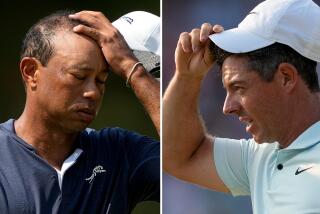Here’s a Golf Tour That’s Rich in Tradition
- Share via
BETHLEHEM, Pa. — Instead of walking off into the sunset carrying a bundle of memories and seeking out a country club job as a means to a livelihood, the touring golf professionals are perpetually invigorated because of what’s happening to them.
Every day they pinch themselves to make sure this is part of reality and not a passing fairway fancy. The Senior Tour allows them to still get their names in the sports pages, and they are contesting for $26 million in total prize money as accrued from 42 different tournaments.
Their cups not only runneth over but they have golden linings.
The U.S. Senior Open, which begins Thursday at the elegant Saucon Valley Country Club, has been received with ecstatic enthusiasm. Tickets are in such demand that a maximum of 25,000 per round has been established so as to make sure the course can accommodate the pedestrian traffic that is crowding to get inside the gates.
The success of the PGA Senior Tour and the U.S. Golf Assn.’s sponsorship of what has quickly become a classic event, its Senior Open, for men over 50, is an ongoing phenomenon. It all started in 1980 with two PGA arranged tests in Atlantic City (won by Don January) and in Melbourne, Fla., (won by Charlie Sifford) and the U.S. Open at prestigious Winged Foot in Mamaroneck, N.Y. (won by Roberto De Vicenzo).
The competition and accompanying applause have been overwhelming, as America refuses to give up such valiant heroes as Arnold Palmer, Lee Trevino, Jack Nicklaus, Gary Player, Chi Chi Rodriguez, Al Geiberger, Bobby Nichols, Bob Goalby and the rest of the alumni that grew to middle age, and beyond, while on the regular PGA Tour.
Instead of going out in a friendly foursome with club members, they are still involved in a league of their own where they maintain reputations and make frequent trips to the bank.
And what are the spectators saying? A typical reaction comes from Lou Sleater, a former major-league pitcher who lives in Timonium, who says, “This is like watching an animated Hall of Fame. The legendary names are still with us and drawing crowds. I believe golf and billiards are the only sports where men in their 50s can compete at a level where there’s little lost in the skill of shot-execution.”
And the demand for tickets is so intense that Sleater, like so many others, had to be satisfied with watching the practice rounds, where the first two days the attendance reached counts of 13,000 and 20,000.
Nicklaus continues to participate on the regular tour and integrates his schedule with visitations to specific senior stops. “I love USGA events,” he comments. “The USGA does the best job of getting a course prepared for a tournament. It’s an organization with paramount respect for golf, and I hold the same kind of respect for the USGA.”
One-hundred and fifty-six golfers, including 34 amateurs, have qualified for the current Senior Open. How it has gained acceptability could not have been predicted.
In 1980, for instance, the USGA offered its first Senior Open to the Baltimore Country Club and its East course at Five Farms. But there was little interest, and with reason. There was simply no precedent for anything quite like this concept hitting the target. But Winged Foot, with little fanfare, took it on almost as an obligation.
So look what has transpired since then. Crowds. Excitement. And rich purses for the players who didn’t even have to think of starting a “second career.”
They merely kept on swinging . . . while confining themselves against men their own age.
More to Read
Go beyond the scoreboard
Get the latest on L.A.'s teams in the daily Sports Report newsletter.
You may occasionally receive promotional content from the Los Angeles Times.










